SEO Strategies for Franchise Businesses in 2025
Key Takeaways
- Franchise SEO involves balancing scalability with local relevance to increase organic foot traffic and enhance brand identity.
- A successful franchise SEO strategy should boost corporate brand authority and visibility while ensuring individual franchise locations rank well locally.
- The focus of franchise SEO is to grow organically for the main website and improve visibility for each franchisee in their local markets, ultimately reinforcing online presence.
Editor’s Note: This post was originally published in February of 2024 and has been updated for accuracy and comprehensiveness.
Building a successful SEO strategy for a franchise website comes with some unique challenges that many “regular” sites don’t have.
First, you’re torn between creating standalone websites or housing all locations under one.
You also have to ensure brand consistency across the locations, but lack control over what other franchisees do, which can make or break the entire brand.
The good thing is that franchise SEO is all about creating a balance between scalability and local relevance. It can increase organic foot traffic to your locations and strengthen your overall brand identity if done correctly.
In this article, I’ll share the pillars of franchise SEO and eight (8) proven strategies to help your franchise business dominate search engines in 2025.
But before we get started:
What Does A Franchise SEO Strategy Look Like?
An effective franchise SEO strategy works in two ways:
- It builds your corporate brand authority and visibility.
- It ensures that other individual locations (franchisees) rank well in their local markets.
In a sentence, your franchise SEO strategy should increase organic growth for the main website and ensure each franchisee is visible to local consumers as well.
For example, let’s assume you own a restaurant in Phoenix, Arizona, and Dallas. Your SEO strategy should make it easy for web users in these locations to find you when they search for terms like “family restaurant in Phoenix” or “where to buy fried cheese in Texas,” while strengthening your overall brand authority for non-local searches like “top family restaurant chains.”
Overall, your local and corporate SEO efforts should strengthen your online presence.
Pillars Of Franchise SEO
There are four major pillars of franchise SEO:
1. Data Accuracy:
Data accuracy, in this context, means verifying that your business information, such as name, address, phone number, and website URL (NAP-W), is accurate and consistent across all listings. This includes your Google Business Profile, online directories (such as Yelp and Angie’s List), and social media platforms, especially Facebook and Instagram.
This is important because Google’s algorithms scan all your listings to understand how to rank your franchise locations effectively.
2. Local Page Optimization (Local SEO)
This entails creating location and specialty pages to target local keywords for each franchisee. A general website with high domain authority isn’t enough – you need hyper-local relevance to rank on the search results for each location. Technically, these pages should be:
- Optimized for local keywords.
- Have unique content (not duplicated from other locations).
- Include local relevant elements such as business hours, directions, staff or team bios, and photos of the location or storefront.
More about this later.
3. Visibility to Generative AI Search Engines via Citations
Google bots and generative AI search engines (like ChatGPT and Perplexity AI) depend on your brand mentions (citations) across the web to determine your credibility and trustworthiness.
So, think of these citations as trust signals or votes. The more your business is mentioned by reputable websites, the more authority and visibility your franchise locations get. And the more authority it gains, the more these Gen AI search engines recommend your franchise locations to searchers with queries for which your brand is recognized.
4. Reputation
Your online reputation directly impacts your SEO and click-through rates. This includes the:
- The number of positive reviews you get.
- Overall star ratings.
- How frequently the reviews are posted.
- The type of sentiment/words in the review.
- How actively you respond to them.
According to WhiteSpark’s local SEO report, reviews and ratings rank #1, #2, and #4 in influencing the conversion rates:
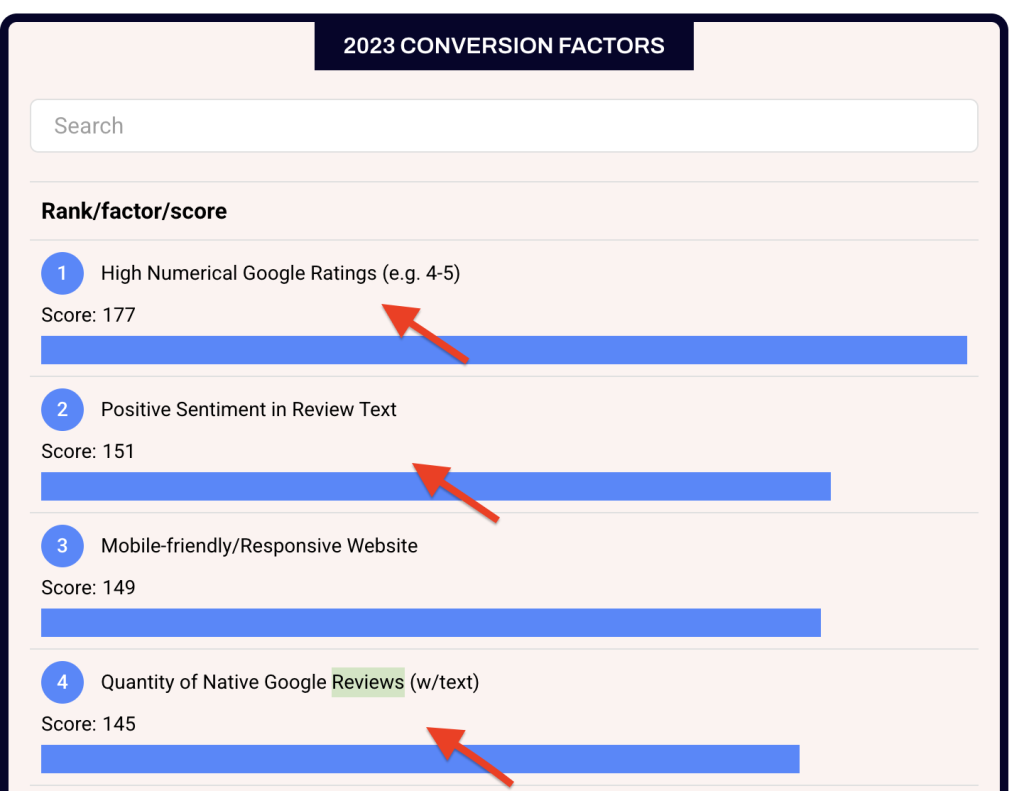
Setting the Foundation
Here are some of the main questions you’ll need to consider when planning a franchise SEO program:
- KPIs: What are your SEO goals and success indicators? Visibility? Higher organic traffic? More leads across locations?
Franchise SEO isn’t cheap (nor easy), so it’s imperative to streamline your efforts to strategies that improve bottom-line results. Here’s an easy-to-use template from Bright Local for creating your KPIs.
- Website structure: Should you host individual location pages (for franchisees) on a subdomain, subfolder, or microsite?
For context, you can choose to create a separate website for each location or a single website for all the locations, and distinguish between franchisees A and B through subdomains or subfolders.
This structure means you can use a single corporate website, “Zerry Maids,” to create pages targeting all service locations. However, you can also choose to create different websites for each franchise location.
This decision will affect how search engines crawl, index, and rank your content, as well as how users interact with your brand across different locations. I’ll explain this further in the first point of the next section.
- Duplicate content: How will you avoid duplicate page issues across different location pages? Having the same or similar content on multiple pages makes it harder for search engines to determine which content to rank in the search results.
- Localized content: How will you optimize each location page for local SEO and create content that resonates with diverse local audiences?
- Maintain brand consistency: How will you ensure a consistent brand identity across your pages, including design, messaging, and user experience, while allowing for local variations?
The right franchise SEO strategy addresses these concerns and adheres to the standard principles of SEO.
So, let’s dive into some key features of a well-rounded franchise SEO:
9 Best Practices for Franchise SEO
In this section, I’ll break down the pillars of franchise SEO into actionable strategies that you can implement to improve your search performance:
1. Host Location Pages On Subfolders To Distribute Link Equity
One of the common questions we get as an agency is whether to create a separate domain for each location or keep them under one domain. My answer is simple: keep your locations on subfolders within your primary domain. For example, yourbusinessname.com/dallas. Here’s why:
When you use subfolders, the entire website works as a unified authority in the eyes of search engines, like this:

This option makes it easy for subpages to enjoy link juice from the main website, which increases their authority and improves their chances of ranking higher in search results for related queries.
Another advantage of using subfolders is that it makes it easier to maintain consistent branding and a unified user experience across location pages. When users navigate from a corporate-level page to a location-specific page, they experience a seamless transition with consistent design, messaging, and functionality. This uniformity creates trust and aids brand recall.
The third advantage of subfolder architecture is that it simplifies the website management process. Since you’re using the same content management system (CMS) across your main site and subfolders, you can update other elements simultaneously, such as headers, footers, and navigation menus, to ensure sitewide uniformity.
Note: Using subfolders doesn’t limit your local SEO efforts for each location. You can use Google’s EEAT (Experience, Expertise, Authoritativeness, and Trustworthiness) guidelines to create unique content for each location. This helps you avoid duplicate content issues or keyword cannibalization.
2. Target Location-Based Keywords To Increase Local Search Rankings:
If you’ve yet to optimize your franchisees for local rankings, you’ll miss out on a massive share of your target audience using local parameters in their search queries. Here’s why:
- Over 97% of consumers use search engines to find local businesses.
- 80% of US consumers search online for local businesses weekly, and 32% search daily.
- 72% of consumers use Google to search for local business information.
- 61% of consumers use Google, Yelp, Better Business Bureau, etc., to find information about a local business they’ve never used.
(Source)
Using geo-specific keywords in your content, such as “near me” or (location), helps search engines understand the local relevance of your pages and rank them accordingly.
For instance, let’s assume you own a franchise restaurant that sells the best French fries in Dallas and Arizona. When people in these cities search for “best french fries near me” or “french fries take outs,” and your listing/website contains any of these keywords (or other location-specific terms), your business is more likely to appear on the search results and map pack.
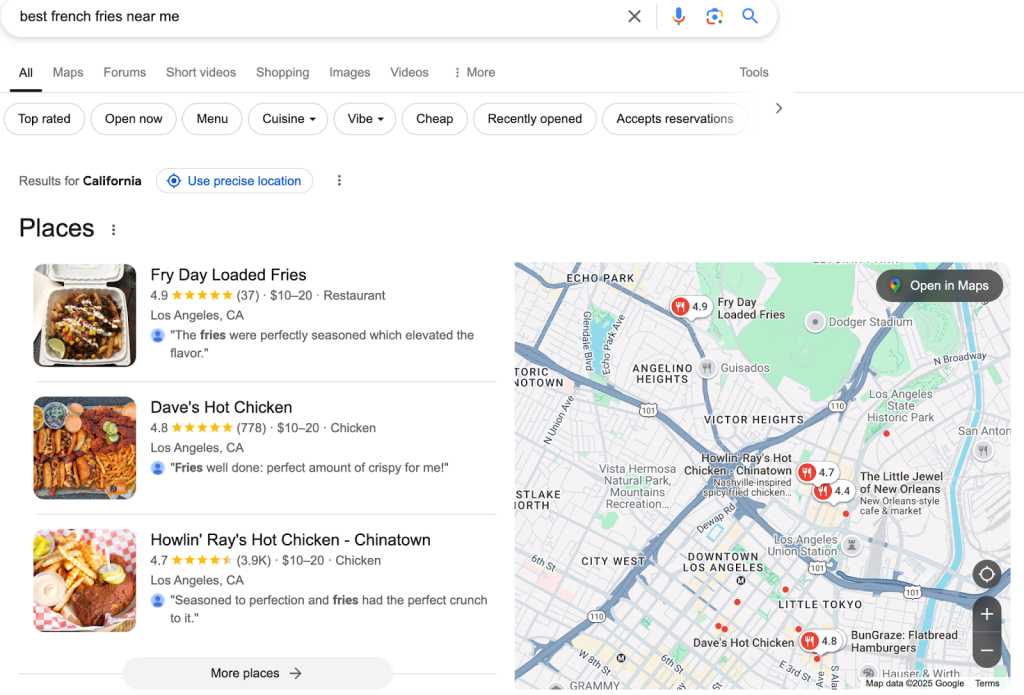
Examples of location-specific keywords are:
- (your service) + (near me).
- (your service) + (city).
- (your service) + (landmark).
- (your service) + (region/state).
You can use SEO keyword tools like Ahrefs or SEMRush to find location-specific keywords for which to rank. Most of the time, these keywords have low difficulty and a good search volume. To find them:
i. Enter all your services/products and the variations into Keywords Explorer. You can add up to 10,000 keywords at a time:
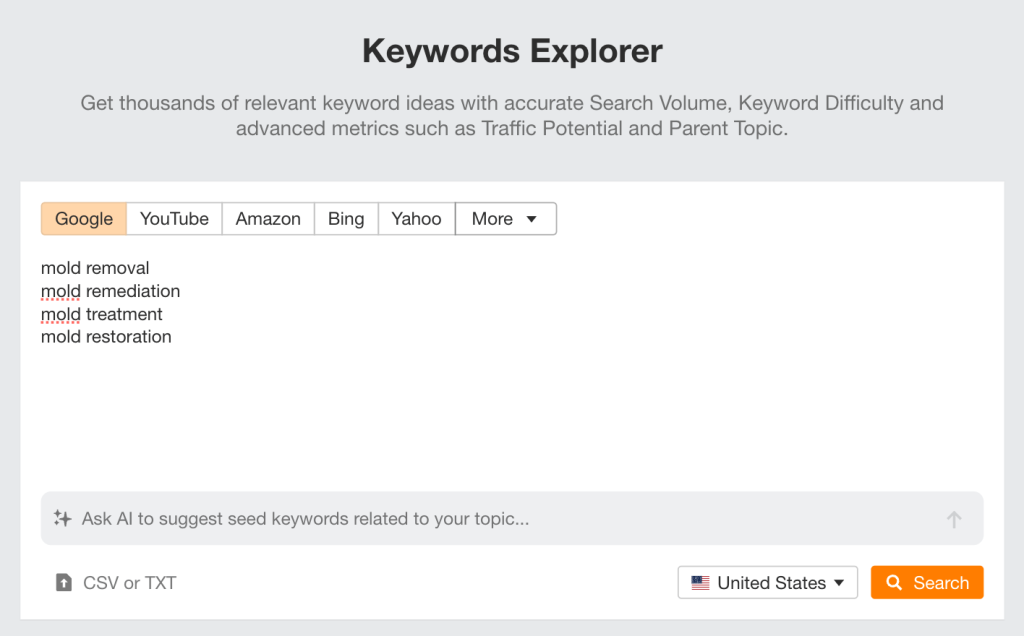
ii. Streamline the results based on your target locations. This can be cities, street names, or even zip codes:
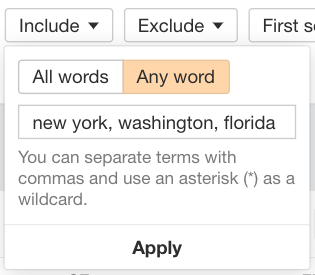
iii. Once you apply the filter, you’ll see a list of location keywords to target for each franchisee:
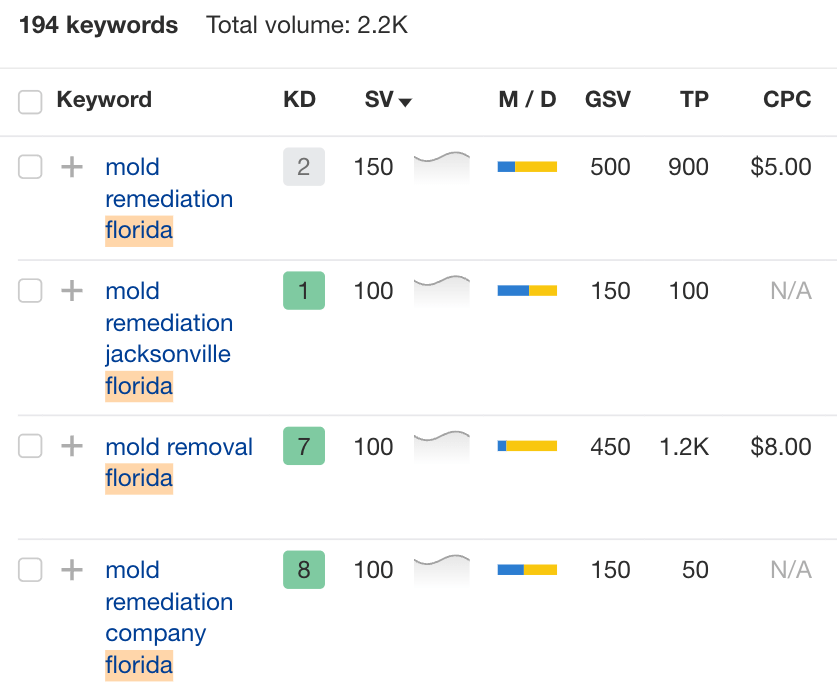
Read more on how to do keyword research for SEO.
This brings us to the next point:
3. Create Location Pages to Appear for Local Searches
Whenever Google believes a query has a local intent – that is, the user searches for a nearby business or includes a specific area in their search – they rank pages closest to the searcher. This is why you need a landing page for each location.

A location landing page is a dedicated page optimized to appear and rank for local searches. Depending on your service areas and target market, it can be modified to a city, suburb, or even state.
Take Servpro, one of the largest commercial damage cleanup franchises. They have dedicated landing pages for each service location:
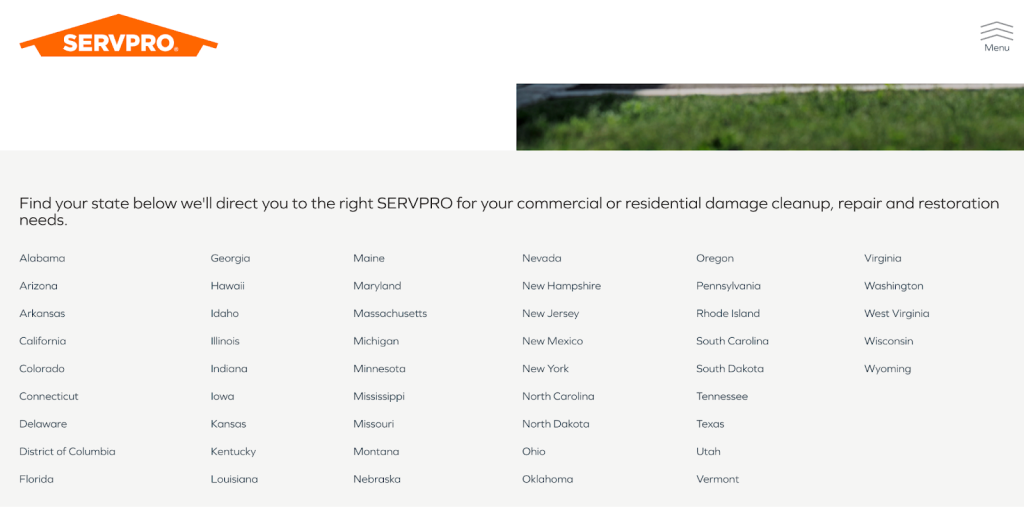
So, when you search for “water clean up service in Kansas,” their “Kansas” location page tops the local search results:
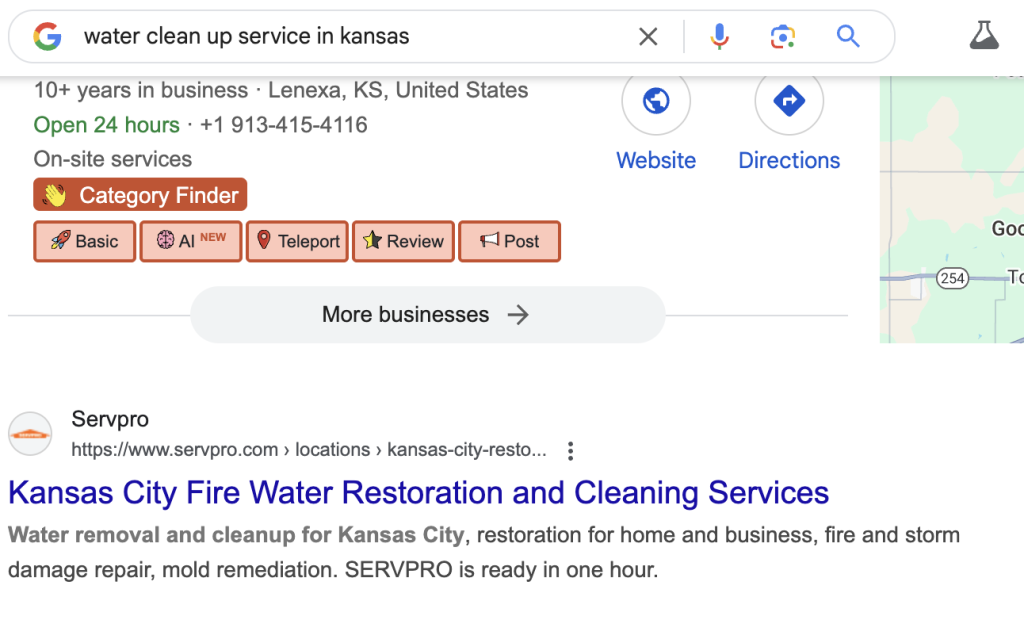
And in “Alabama”
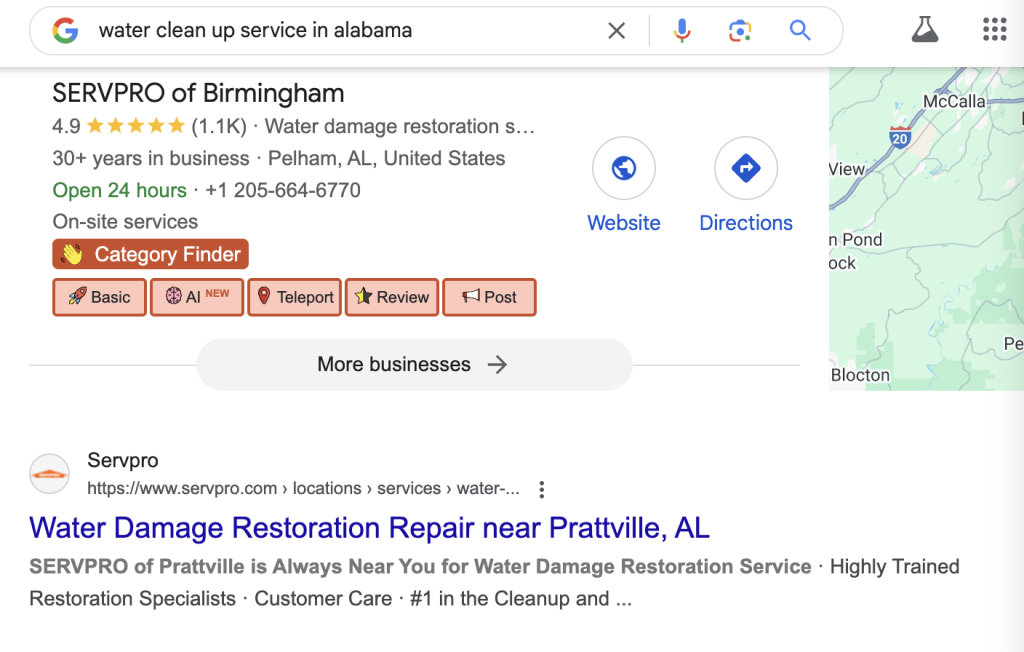
There are five types of location pages:
i. Primary location page:
This page usually contains a search box to help visitors find a location near them. This page may also include links to the state and city pages, like this:
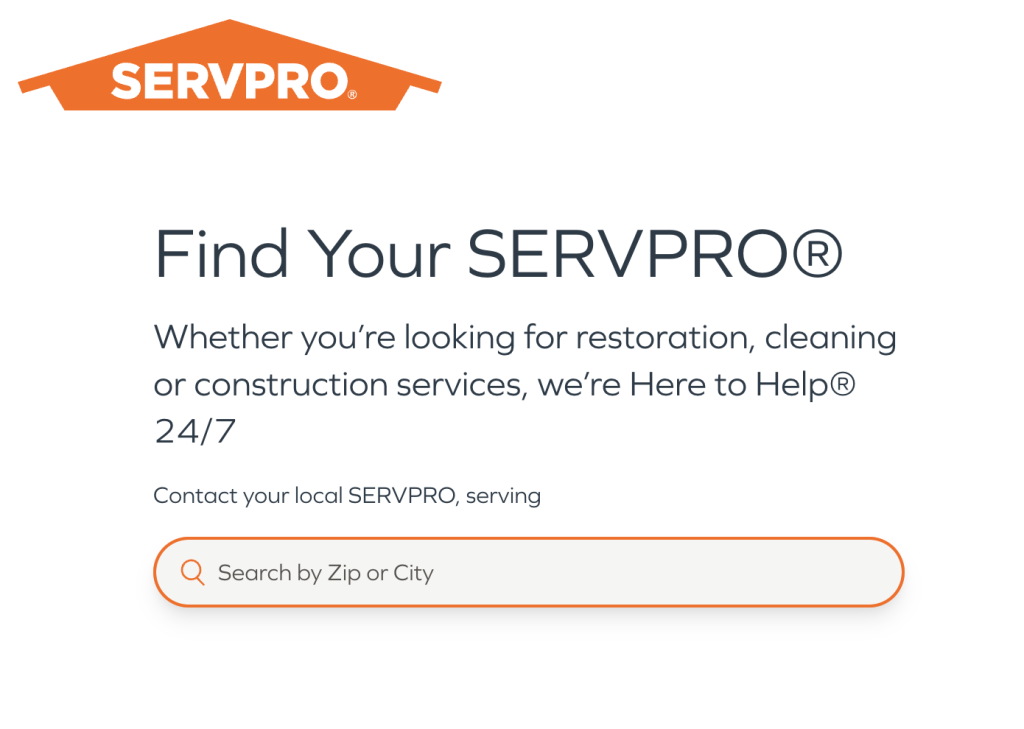
This page works if you serve in more than one state or over 20 locations across multiple cities.
ii. State page:
This page is best for businesses that serve locations in one or two states. The page links to all the cities you serve within the state. It looks like this:
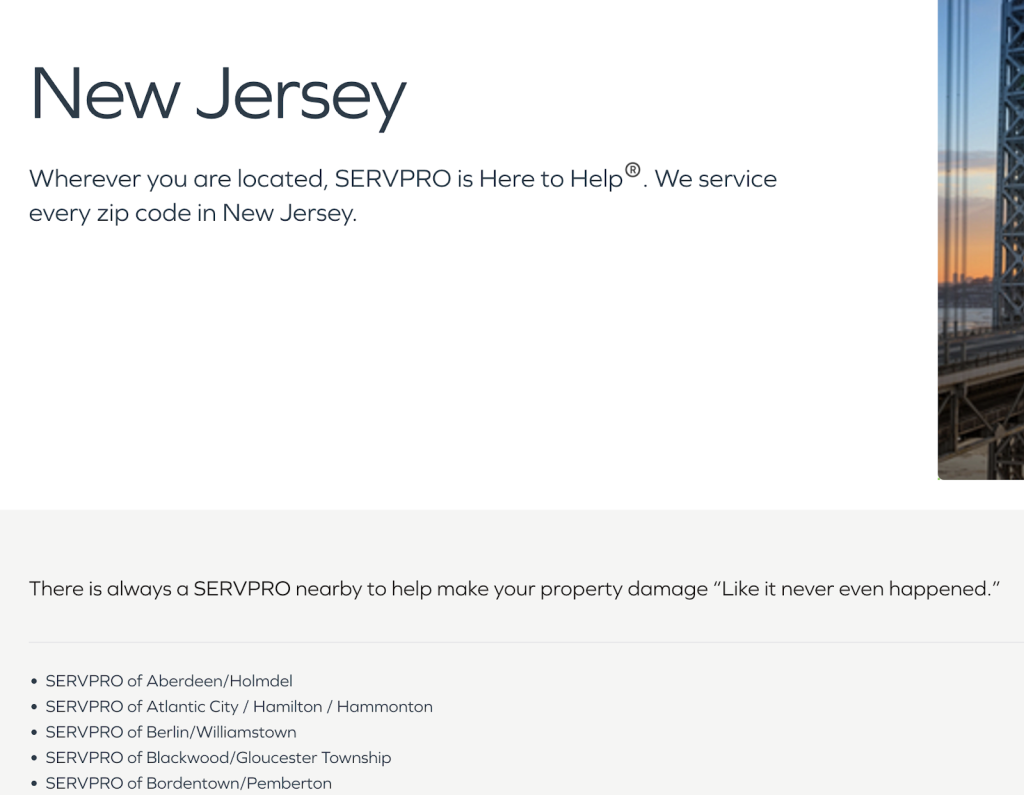
iii. City Pages:
This page lists all the locations where your business is located in a specific city. And if you have just one area in a town, you can use a temporary redirect to point users to the individual location page instead of the generic city page. This is another example from Servpro:
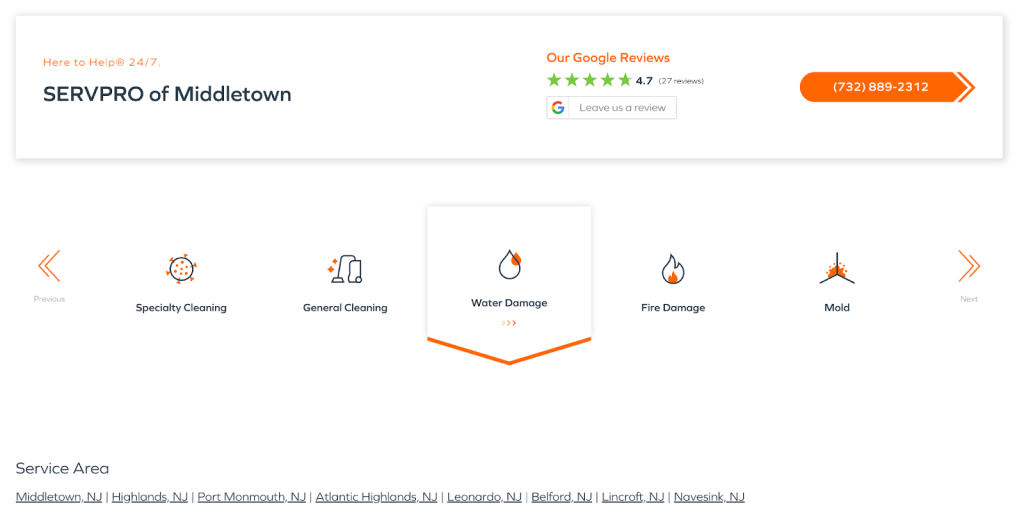
iv: Individual location pages:
An individual location page focuses on a single, specific branch or outlet of your business. This is where you share complete details about the location, such as the address, phone number, opening hours, parking information, and directions.
You can also embed a Google map, add location-specific reviews to boost local relevance, and “hyper-local” content to show local relevance:
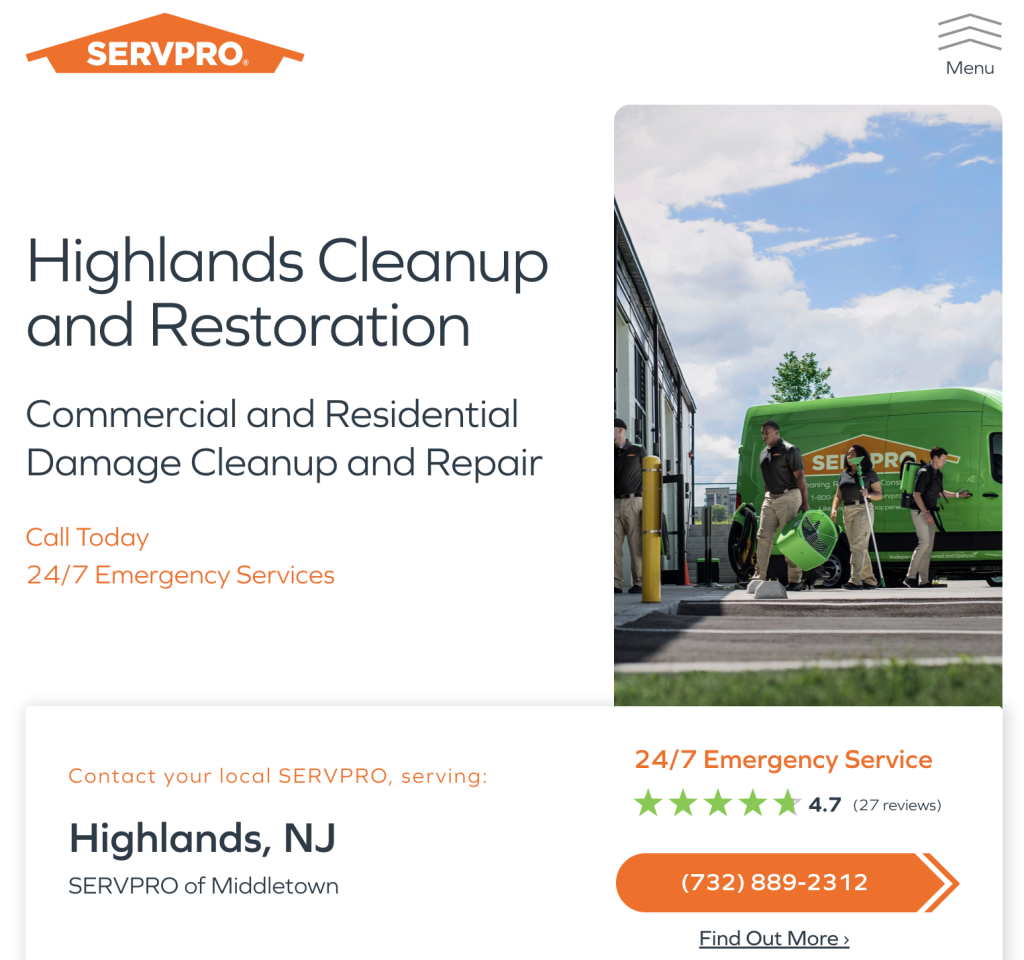
v. Specialty pages:
Specialty pages are web pages dedicated to a specific product, service, or any other aspect of your business that operates in multiple locations. They’re also optimized to target local search queries and contain detailed, location-specific content, which helps them rank in local search results.
As you can see, all these pages serve different purposes but can help you rank higher in search results for city, region, state, or national-related keywords.
4. Optimize Your Google Business Profile Listings to Appear for Near Me Searches
Your GBP listing is one of the most powerful tools for dominating local search results, especially for “near me” queries. Google pulls information from these listings to deliver relevant results to user search queries.
For example, when a user searches for “best French fries near me,” the top three GBPs optimized for this location appear on the local map pack:
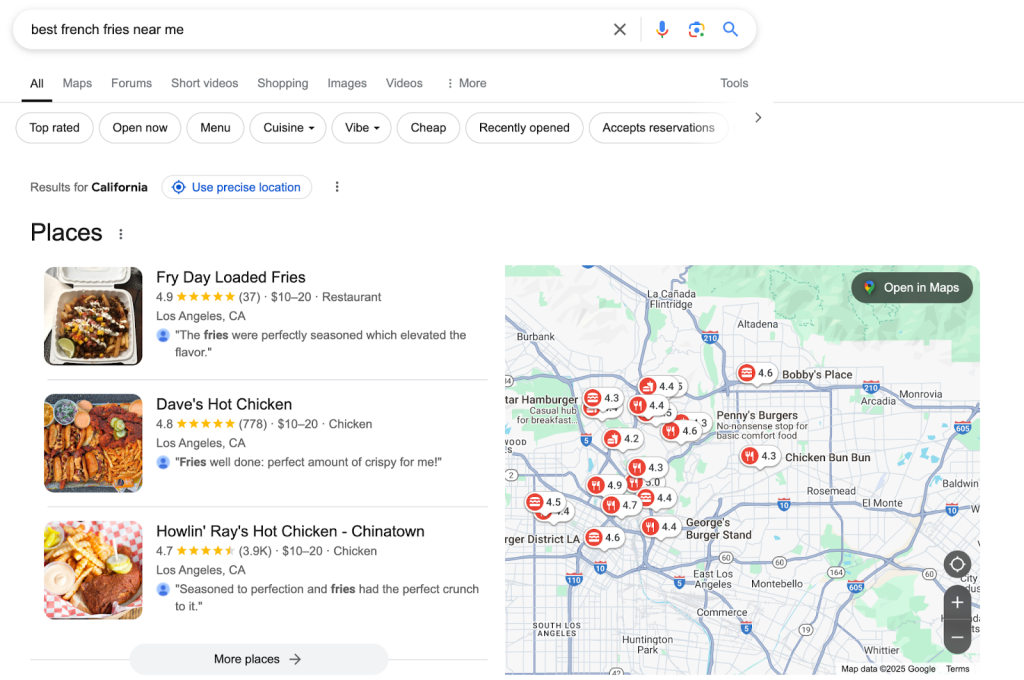
Neil Patel analyzed 119,221 URLs and found that this “golden” feature in search results funnels approximately 44% of all clicks.
To optimize your Google listing:
i. Ensure Consistent NAP-W:
Consistent NAP-W information across the web helps search engines establish your business’s legitimacy and credibility and increases your likelihood of ranking for relevant local searches.
Consistent NAP-W information also prevents confusion and misdirection. Customers who can easily find accurate information about your franchise locations are more likely to visit than those who don’t.
Conversely, inconsistent information can lead to missed opportunities for your business and damage your brand’s reputation.
ii. Add local keywords to your description and title
Your GBP description and title should include relevant local keywords that align with how people search for your services in your area. This is the second most crucial factor for ranking on the map pack, according to the 2023 WhiteSpark local ranking factors:
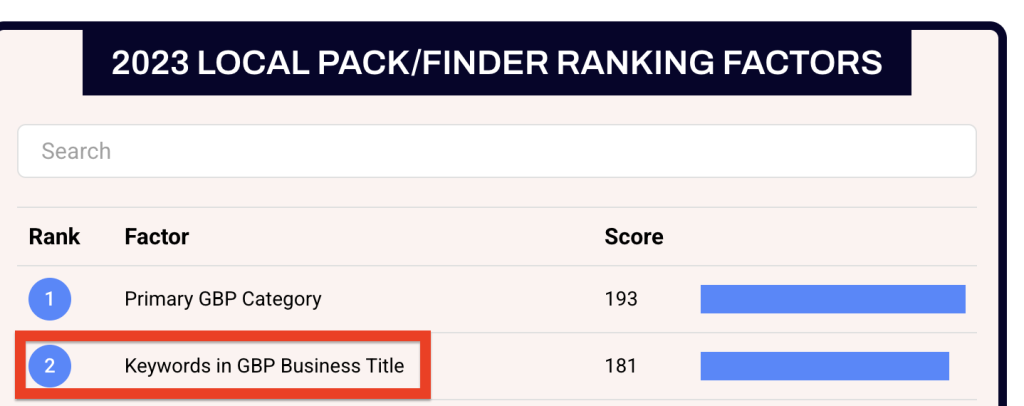
These local keywords in your business titles and descriptions help Google associate your listing with specific local search queries. See this example below:
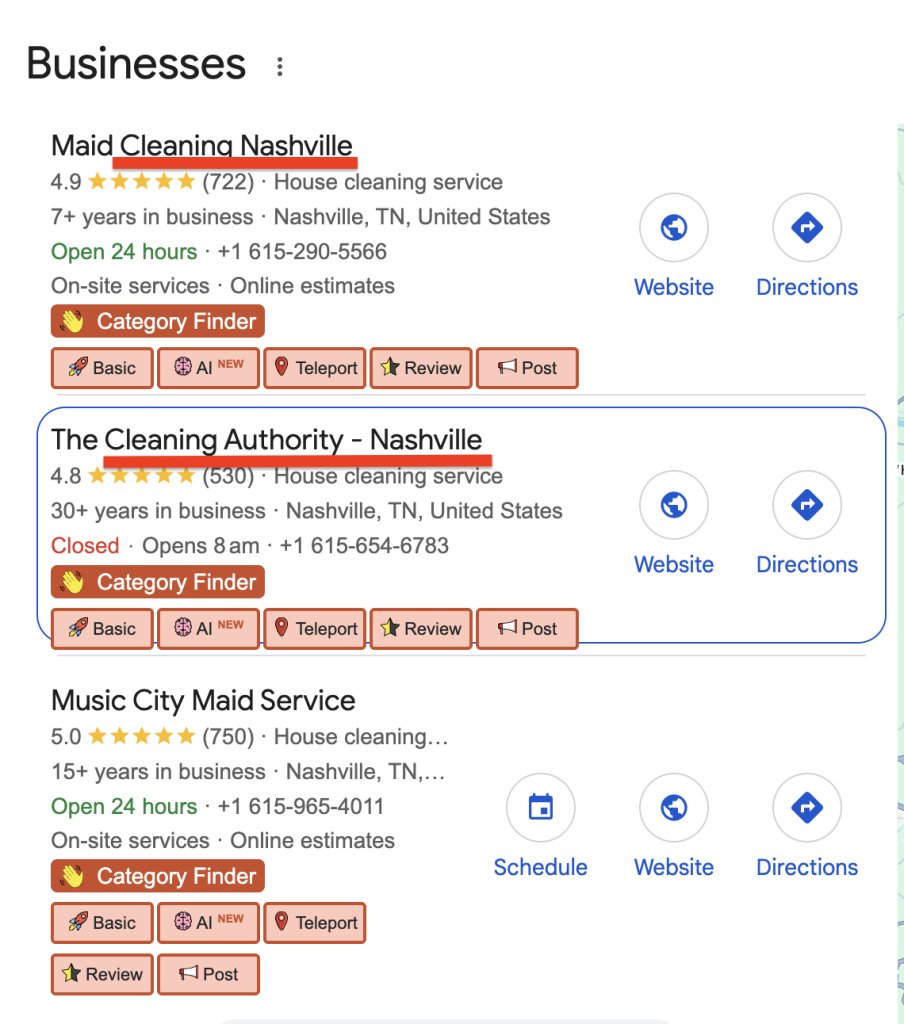
Here’s the description for the same brand. It contains hyper-local keywords such as “cleaning services in Nashville” and “best house cleaning in Nashville.”
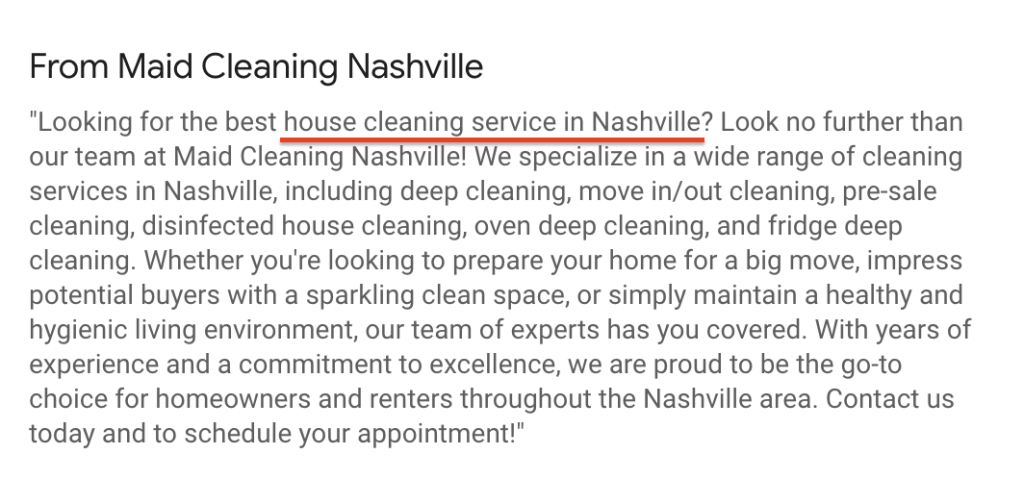
Tip: Weave the keywords naturally into the title and description.
iii. Include attributes
Attributes provide extra details about your business that help it stand out in search results.
They help Google match your business with more specific user preferences and increase your chances of appearing in filtered local searches, especially those without local keywords. For example, “french fries takeout,” “french fries restaurants open now,” etc.
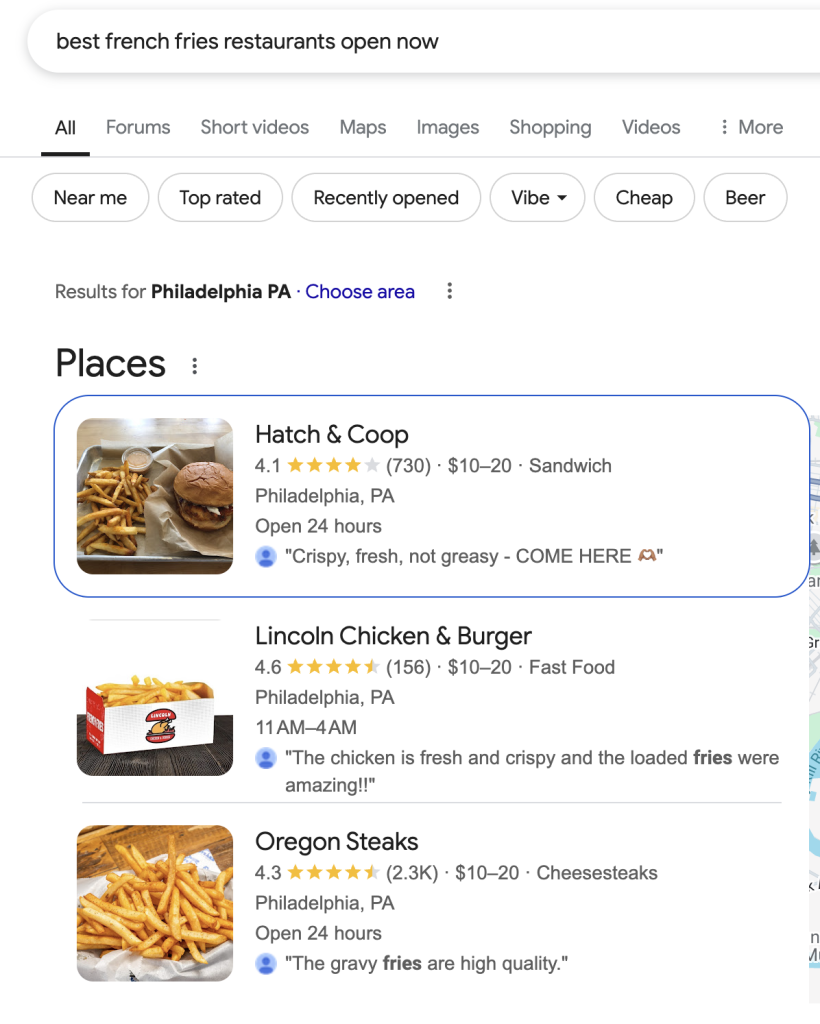
iv. Choose the Right Primary Category
Your primary category is the number one ranking factor for appearing at the top of the map pack. It determines how your listing appears for relevant searches:

This is why you must choose the category that most closely aligns with your primary service — for example, “Fast Food Restaurant” or “House Cleaning Service”. You can also add secondary categories to reflect your additional services, such as “Snack Bar,” “Cleaning Service,” “Janitorial Service,” etc.
Tip: Since you have multiple profiles, claim them and add them to a single business profile as a Google Business group.
Read more on optimizing for the local map pack.
5. Follow Google’s EEAT Content Guidelines to Increase Trust at the Local Level
Local search (and franchise SEO) is built on trust.
Google wants to recommend businesses relevant to user searches and credible in their local areas. They use the EEAT guidelines to evaluate content quality and determine which content should rank and in what order. Although it’s not a direct ranking factor, it shapes Google algorithm decisions.
And when your content aligns with these guidelines, it increases your chances of ranking in the local search results for all your service areas.
A strong EEAT presence = Higher rankings = Better customer engagement.
Let me explain what the EEAT guidelines mean and how they apply to local content:
i. Experience
Your content should show that you genuinely understand your local market and have real, on-the-ground experience. This means highlighting local success stories, customer reviews from specific locations, or photos of your team serving customers in the area.
ii. Expertise
Expertise refers to your in-depth knowledge or skills about a topic. For example, this can be sharing thought leadership content authored by industry experts or adding relevant citations for health blogs. See this example from Investopedia:

It shows Google and readers that the content can be trusted since it was reviewed by a subject-matter expert.
iii. Authoritativeness
Authoritativeness refers to your credibility ratings in your niche and local area. It shows how reliable you are, and as a result, it is important to both Google and users.
This means creating quality, expert-backed content and earning backlinks from credible local and industry sources, among other things. The more reputable (in terms of mentions) your business is, the higher your chances of getting the top spot (including AI Overviews) for local queries.
Tip: Partner with local influencers, collaborate with neighbourhood blogs, or get featured in local news outlets. When trusted local websites reference your business, Google is more likely to see you as a leader in your community.
iv. Trustworthiness:
Trustworthiness ensures that your content is accurate, reliable, and transparent. This means providing accurate, up-to-date information across listings, secure browsing using HTTPS, certifications, reviews, etc.
For example, we displayed all industry-relevant awards on our website, including local ones, to show recognition from trusted authorities and build credibility with users and search engines. This reassures potential customers that our business is reputable.

Read more about Google’s EEAT content guidelines and how to integrate them into your content strategy.
6. Implement Schema Markup to Appear for Rich Results
Structured data, also known as schema markup, is a way to classify information about a web page. It’s code that helps search engines better understand your website content, such as:
- The exact address of each location.
- Phone number.
- Opening hours.
- Services.
- Geo-coordinates, etc.
This helps them to identify and display key details about your website for “rich results.”
Here’s how it looks:
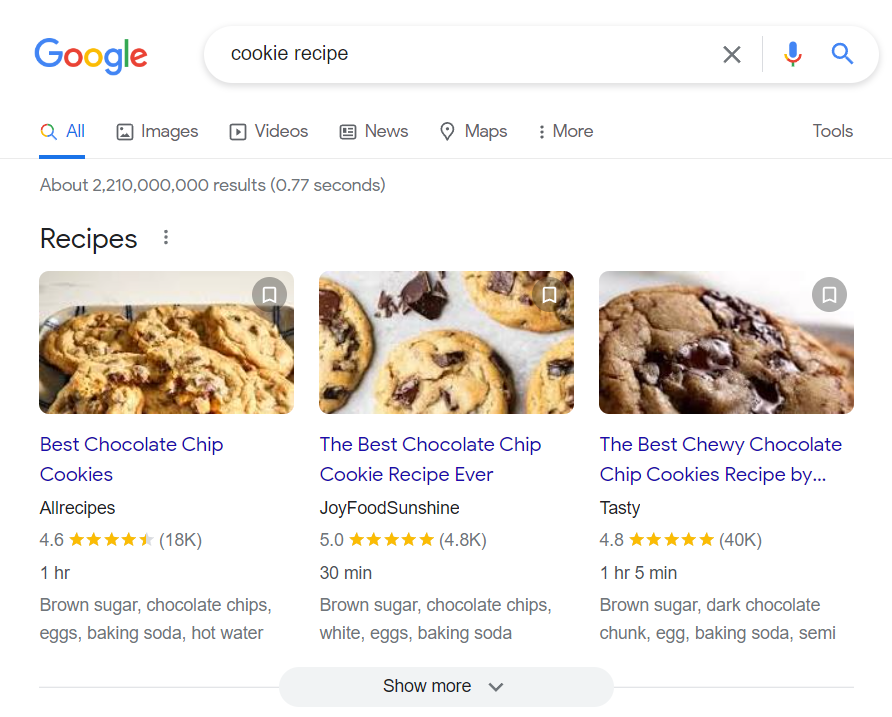
For example, the “Aggregate Rating” property provides details about the average rating of a product or service based on multiple reviews.
Search engines can then use this information to generate a rich result, which makes your website/listing look more appealing on the search results:

One of the most valuable structured data types for franchise location pages and listings is the “LocalBusiness” property. This allows you to provide specific details about each location, such as name, operating hours, and services offered.
Adding as much information as possible to this property can significantly improve the relevance and richness of your local search listings.
7. Encourage Customers To Leave Reviews To Increase Local Trust
Customer reviews are one of the strongest signals for local SEO.
They build trust in the minds of your prospects and improve your search rankings:

Encourage customers to leave reviews on your Google Business Profile. You can do this in several ways:
- Ask them at the checkout.
- Integrate an automated email campaign after each purchase that asks customers to leave feedback.
- Send push SMS with links after purchase or appointment. See this example below:
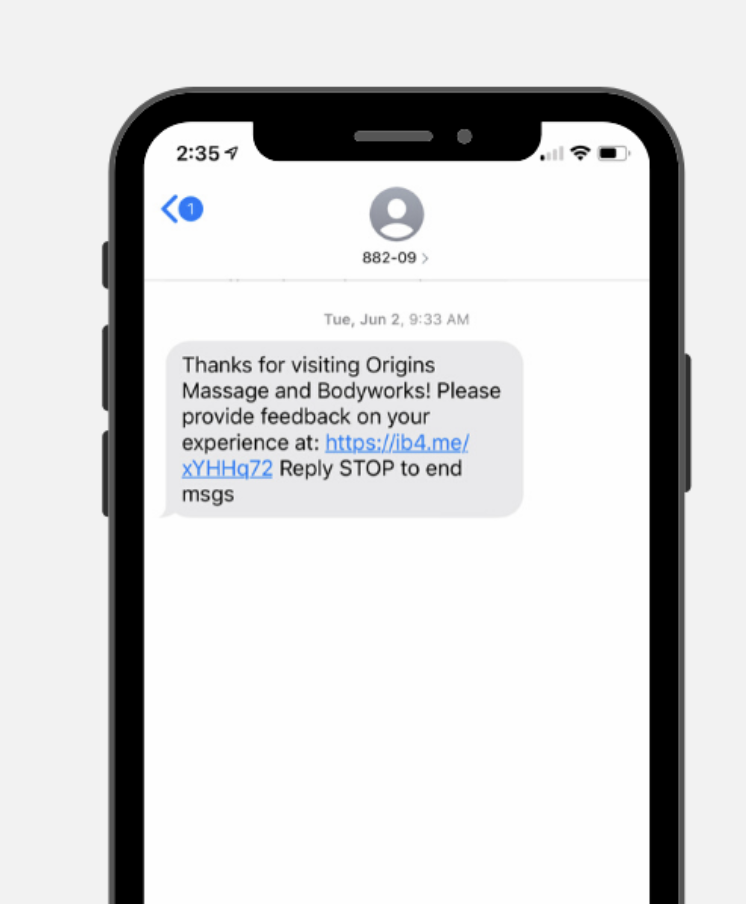
It’s equally important to respond swiftly to reviews, according to Google:
“When you reply to reviews, you value your customers and their feedback. High-quality, positive customer reviews can improve your business visibility and increase the likelihood that a shopper will visit your location.”
Moreover, user reviews often contain relevant keywords and phrases you might not have used on your website. So, as you accumulate more reviews, you increase your chances of ranking for a broader range of long-tail keywords.
8. Manage Duplicate Content To Avoid Keyword Cannibalization
Replicating the same content across multiple location pages can make it difficult for search engines to determine which content to rank in the search results. When too many pages compete for similar keywords, it leads to keyword cannibalization (conflicting keywords), which dilutes visibility and hurts rankings.
To avoid this, create location-specific content for each franchisee. You can add service descriptions, customer testimonials, landmark pictures, and even embed maps on the location page.
In some cases, it’s okay to reuse parts of a specific content across different sections. For example, you might need to use the same service descriptions or legal disclaimers on multiple location pages, especially if your services are consistent across all locations.
When you can’t avoid duplicating content, use canonical tags to clarify the relationship between the pages. This helps search engines understand which one to rank on the search results.
Here’s an extra tip to boost your SEO efforts:
9. Use Community-Based Marketing to Build Awareness
Community-based marketing is a powerful way to increase local visibility and connect authentically with the people in the areas you serve.
With this type of marketing, you can:
- Promote your franchise.
- Build genuine relationships with the residents.
- Drive organic, word-of-mouth promotion.
- Increase brand awareness and sales without relying on search engines.
- Strengthen your local reputation.
- Become a household name for your product or service.
A good example of franchisees using this strategy is Chick-fil-A. Some of its locations organized a community care event to donate 10% of the day’s sales to Make-A-Wish Philadelphia, Delaware, and Susquehanna Valley. This fund will be used to support children with critical illnesses:

To participate, customers will download the Chick-fil-A app and select “yes” to “Support Community Care Event” at checkout. This is a simple way to promote customer-led participation while improving local relevance.
There are several ways to integrate community-based marketing into your SEO strategy:
- Host in-store events, such as free tasting days, hackathons, or networking meetups, at each franchise location.
- Sponsor community festivals, sports, charity, or school programs.
- Organize challenges on social media using community- and brand-specific hashtags to increase social mentions. See this example from Glossier:

Read more on community-based marketing and how you can be successful at it.
Conclusion
Successful franchise SEO involves creating a balance between brand consistency across location pages and local SEO.
Global factors, such as brand messaging, site structure, and user experience, should remain consistent throughout your franchise website. Your location-specific pages should also be optimized for local searches.
Doing this will improve your franchise search performance, attract more local traffic, and help you maintain a strong, unified brand identity across different markets. If you don’t know where to start or need a custom strategy for your website, schedule a free call with one of our franchise SEO experts. We’ve helped hundreds of franchises scale online with profit-focused digital marketing strategies, and we’re excited to see you achieve the same results.
